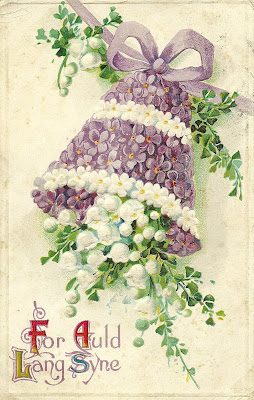Do you have a Union Civil War
veteran in your family tree? If so, have you checked to see if he joined a
local Grand Army of the Republic (G.A.R.) post?
G.A.R. units sprang up in
communities throughout the U.S. (especially the northern states) in the latter
part of the 19th century. While essentially a fraternal organization offering
camaraderie for Civil War vets, G.A.R. meetings also provided men with
information about things like changes in pension laws or requirements. Each
local Post was part of a statewide Department, which in turn reported to the
national Commander.
And lucky for us, they kept
good records of their members. Many have been lost, but some have survived and
are now in various archival collections.
What can G.A.R. records tell you about
your ancestor?
The most helpful information often
comes from a record-keeping journal called the Post Descriptive Book. This is essentially
the local post’s inventory of its members. The post descriptive books that I’ve
seen (all from Ohio) contain the following:
- Veteran’s name
- Member number (indicates order in which he joined
the post)
- City or township of residence
- Occupation
- Date of birth
- Place of birth (city or county if same state,
otherwise name of state or foreign country)
- Date of military enlistment
- Military rank
- Company or companies he served in
- Date of discharge
That’s a lot of good information!
Other sources to look for include the post’s
application for charter, its members’ applications for membership, and the
post’s quarterly muster rolls. If you discover your ancestor was an officer of
the post or served as a delegate to one of the Department (state) or National
Encampments, you might find even more records of interest.
How do you know what post your
ancestor might have joined?
Men typically joined the post
closest to where they were living at the time. So the first thing to do is find
your veteran in the 1870,1880, and 1900 federal censuses, and perhaps the
surviving remnants of the 1890 veteran’s schedule. City and county directories
can also be helpful.
Once you know his residence,
visit the Sons of Union Veterans of the Civil War’s Grand Army of the Republic (GAR) Records Project. They’ve assembled
state-by-state listings of all known G.A.R. posts. You might also check old
county histories, which often named the local G.A.R. units with pride. In
addition, the obituaries and cemetery markers of former soldiers sometimes
indicate their G.A.R. affiliations.
Most G.A.R. posts are
identified by both a number and a name. The name was often selected to honor a
local military or public figure. I'd also like to mention that Larry Stevens has compiled a very helpful list of Ohio G.A.R. Posts, organized by county.
Where can you find G.A.R. records?
The FamilySearch Wiki article, “Union Veterans’ and Lineage Society Records,” is a good place to start. It indicates that the
Family History Library has films for Iowa, Michigan, Nebraska, Oregon, South
Dakota, and Utah G.A.R. units, and discusses Illinois records. Collections for
Kansas and New York are available at Ancestry.com.
If your ancestor didn’t live in one of those states,
your best bet is to check your state archives or state library to see if it has
any G.A.R. records in its collection. You might also check university libraries
or other regional or local repositories. Since I’m most familiar with Ohio,
I’ll use that as an example. A search for “Grand Army of the Republic” in the
Ohio History Connection’s (OHC) Online Collections Catalog of manuscripts and state archives returns a number of results. Among them is MSS 715: Grand Army of the Republic, Dept. of Ohio Records, 1876-1936.
Now, normally I’d suggest you look at the
collection’s finding aid to see exactly what it includes, but this particular
collection is in the process of being reorganized for better preservation, and
the new finding aid isn’t out yet. The records are still available for use, though,
and the archivists are happy to help you find what you need. I’ll warn you that
the holdings are hit-or-miss, with good records for some posts and next to
nothing for others. I suspect that’s probably the case in other states as well.
Those of you with Ohio connections might like to know
that OHC has the post descriptive books for Posts 34, 107, 109, 665, 674, 704,
717, 728, 746, and 752. They also have a scattering of muster rolls,
applications for charter, election reports, minute books, encampment registers,
and financial account books.
For example, here’s the application for the charter
of Post 156, known as Groce’s Post, in Chillicothe, Pickaway County, Ohio. It
was chartered on 4 November 1881:
Notice all the different inks and handwritings. It
looks like each of these charter members filled out his own information, giving
you his signature and a sample of his handwriting. Pretty cool, huh? Of course
the post went on to gain many more members—this just documents those who were in on
its founding. And it doesn’t provide any personal information. That’s why the
descriptive books are such gems, when you can find them. This particular one is
missing.
Will G.A.R. records tell you who your ancestor’s
parents were?
Well, no, at least not directly. But they can
provide additional pieces of evidence to help you identify potential parents
and answer other questions about him. And they give you a ready-made circle of
friends and associates who knew him, which can lead to more records. In
genealogy, widening the circle around your target can be just the ticket to
narrowing in on the answer you seek.
If you’ve used G.A.R. records, I’d be interested to
know what you found. And if you haven’t, I hope this might encourage you to
give them a try. It’s one more way to uncover the fascinating story of your
Civil War veteran’s life.
--Shelley
G.A.R. postcard image courtesy of Wikimedia Commons, attributed to Derry Public Library.
Related Posts:














